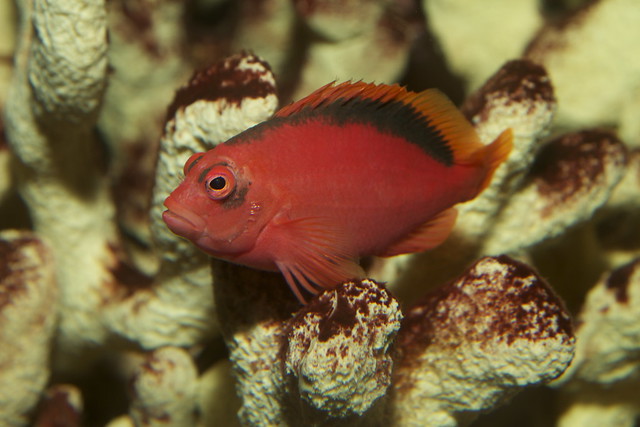 |
| Photo by brian.gratwicke |
Their descriptive name attributes to two distinct characteristics. Flame is derived from their bright reddish-orange coloration. They have a dark often black horizontal stripe along the curvature of their upper bodies. This stripe very much resembles a Mohawk. However, the word hawk refers to the darkened regions surrounding their eyes. These dark areas are reminiscent of the black circles found around the eyes of many hawks.
This is a rather robust, disease resistant species. They make for good additions to a community tank. They generally ignore non-bottom dwellers. They will, however, demonstrate territorial behavior toward other bottom-dwelling fish. It is therefore recommended that this be the only bottom dwelling fish species in your aquarium. They can grow to a maximum adult length of 4 inches and may live in excess of 10 years.
Whether or not they make suitable marine reef fish depends on the inhabitants in your tank. Their natural diet consists primarily of crustaceans, snails and smaller mollusks. They also have an affinity for hermit crabs. Coral is generally off the menu, especially hard coral. They will view these as a place of natural habitation. This is a diurnal species. It will be most active during the day and will seek shelter at night.
These fish may show a reluctance to feed initially. If they are newly captured they may not eat at all. This could simply be a matter of not recognizing common marine food as a source of nutrition. If feeding becomes problematic try tempting them with a treat similar to what they would eat in nature. Live brine shrimp should do the trick. In time they will learn that dried shrimp, a frozen food developed for carnivores and possibly even flake food are acceptable menu choices.
Flame hawkfish are prone to experiencing a loss in their brilliant coloration in captivity. This is most likely due to an as yet unidentified nutritional deficiency. Regular supplements of vitamin enriched brine shrimp and chopped fresh seafood such as shrimp, squid and crab will help to keep them healthy and prevent a reduction in color intensity. Maintaining an abundant supply of living rock will also prove beneficial.
I nature this species lives in small communal harems. A single male will be accompanied by anywhere from two to ten females. No obvious coloration differences exist between males and females. Males, however, tend to be a bit larger than the females. In the wild mating occurs at dusk. Eggs are left to drift away in the current.
Hawkfish are protogynous hermaphrodites. They are all born as females. If a group of females is introduced into an aquarium, the largest most dominant of the bunch will undergo a morphological transition into a male despite the fact that they are not known to breed in captivity.
Technological advancements in the aquarium industry continually redefine the concept of "home aquarium ownership." Just twenty years ago not even the biggest public aquarium was capable of keeping jellyfish alive in captivity. Now they make desktop Jellyfish Fish Tank Aquariums. And why would you want a jellyfish tank? Perhaps you should check out what the translucent bodies of Pet Moon Jellyfish look like under LED lighting. Pet Jellyfish give a whole new meaning to the term exotic pets.
Article Source: EzineArticles
|
